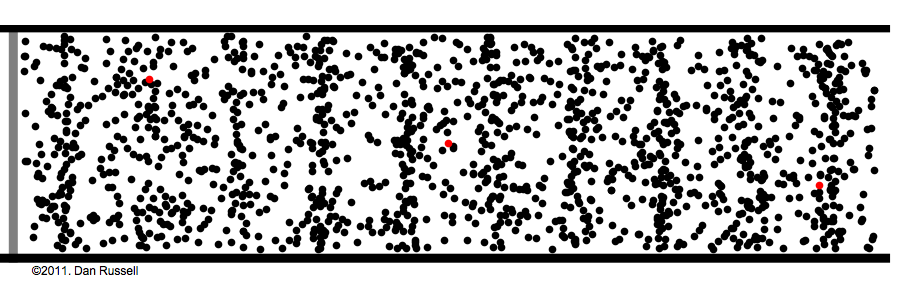...
as pressure drops, mean free path increases, because there are less molecules to run into. This effects the behavior of gasses, discussed below:
Pressure waves: pump up the bass
Under normal atmospheric conditions– gas molecules are constantly running into each other (short mean free path) and bouncing off.
Hold your hand in front of your mouth a few inches away and say "pump". Do you feel that air hitting your hand? Try saying "pump" again with your hand farther away. How far can you get and still feel the "p"?
Here's another example: sound
In fact, when you blow out a candle it's not the molecules from your lungs that put out the flame, there are too many air molecules in the way; your lung-air molecules merely knock forward the air molecules in front of your mouth, which knock forward the air molecules above the cake, which in turn knock the air molecules in the flame away from the wick, taking their heat with them, and extinguishing the flame.
Though if you keep blowing those lung air-molecules will
And pumps create suction in just the opposite way: remove some molecules and the ones next to it fall into the void, leaving their own void behind them, which gets filled by other molecules, and so on and so forth. This domino-chain like behavior is called viscous flow, and it's what we're used to.
Flowing through a pipe
Viscous flow: like a river
...
In fact, when you blow out a candle it's not the molecules from your lungs that put out the flame, there are too many air molecules in the way; your lung-air molecules merely knock forward the air molecules in front of your mouth, which knock forward the air molecules above the cake, which in turn knock the air molecules in the flame away from the wick, taking their heat with them, and extinguishing the flame.
Though if you keep blowing those lung air-molecules will
And pumps create suction in just the opposite way: remove some molecules and the ones next to it fall into the void, leaving their own void behind them, which gets filled by other molecules, and so on and so forth. This domino-chain like behavior is called viscous flow, and it's what we're used to.
...
Ok, so you know how I said molecules bounce off walls? Not actually true. I lied to keep it simple, but I think you're ready for the truth: It turns out that any time a gas molecule hits a surface it actually sticks to that surface, just like how your breath fogs the mirror; this called adsorption (not to be confused with absorption).
And also just like fog on a mirror vanishes over time, those stuck molecules will eventually jump back off of the surface (I.e. evaporate, outgas, desorb), flying of in a random direction just as fast as it was when it hit the surface.
How long does the molecule stay stuck before desorbing from the surface?
Well that depends on the molecule, the temperature, and the what the surface is made of; and it can happen anytime between almost instantly and basically never.
If a type molecule tends to jump off quickly, from a given surface at a given temperature, it will find it's way into a pump pretty quickly, and the pressure will drop. And if a type molecule tends to jump off rarely, from a given surface at a given temperature, the pressure also goes down, it's not even contributing the the pressure, because it's not a gas, it's trapped on the surface!
The trouble for lowing pressure comes when a molecule jumps around enough to raise the pressure, but not enough to easily find it's way into the pump.
Contamination: molecules sticking to walls intermittently
...
And this topic is really beyond what this document is about (introduction to theory), but keep exploring! For more details on Vacuum System parts and how they actually work, see the confluence pages on vacuum components
In Depth slides: Vacuum Science and Technology for Accelerator Vacuum Systems
...


